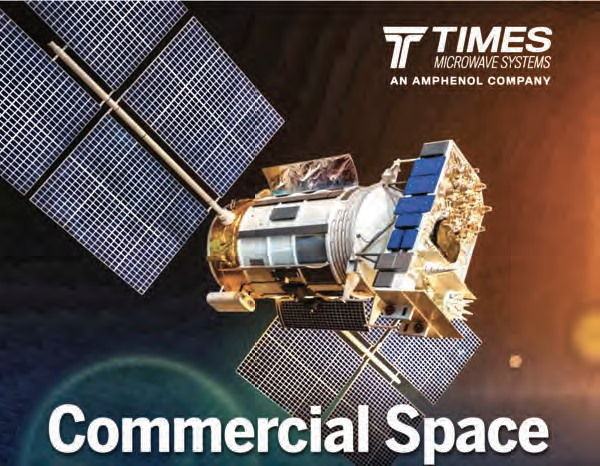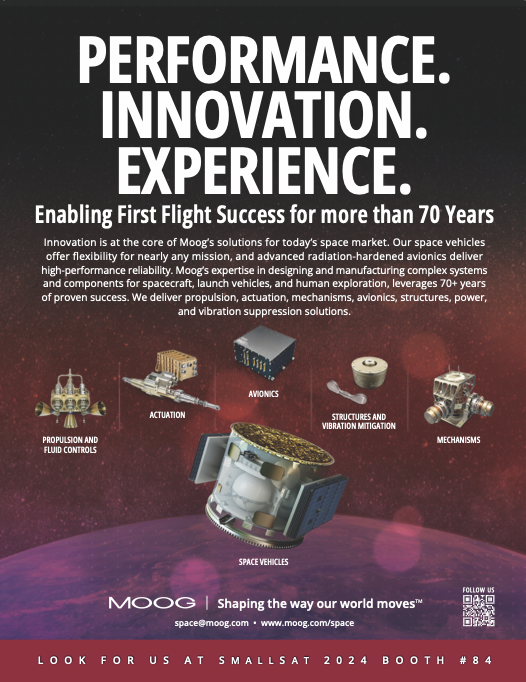Adapting RF cable assemblies
With the exponential growth of the commercial space industry, Low-Earth Orbit (LEO) satellites are becoming increasingly prevalent — thousands of these satellites are now orbiting the Earth.

LEO is the closest orbital range to Earth, with an altitude of between 500 and 2,000km. Satellites in this orbit cover a smaller area of the Earth’s surface, resulting in shorter communication latency, so they are well-suited for applications that require real-time data transmission.
They operate by orbiting the Earth at relatively close distances in interconnected constellations to form a network that enables global coverage. These satellites communicate with ground-based stations — composed of antennas, communications networks, and processing facilities — to transmit and receive data.
In comparison to larger geostationary orbit (GEO) satellites, which operate in higher orbits and are typically used by government agencies such as NASA, LEO satellites operate at higher frequencies and offer faster communication and reduced latency due to their lower altitude positioning and high-speed travel around the Earth.
They are also close enough to accommodate frequent visits to specific areas on the Earth’s surface, allowing for up-to-date information, improved responsiveness, and resupply.
RF cable assemblies play a pivotal role in advancing LEO satellite communications. They provide reliable connectivity, flexibility, and high performance in demanding space environments, serving as the crucial link between vital systems, including communications, signal transport, payload, and processing.
A Growing Industry:
New Applications
For LEO Satellites
The demand for LEO satellites is on the rise, driven by the need for real-time data transmission, global coverage across various sectors, and declining production costs. With the diversity of potential applications, LEO satellite technology has the potential to play a pivotal role in many industries.
From enabling global communications and widespread broadband internet connectivity to advancing scientific research, earth observation, and enhancing navigation and positioning systems, these satellites are at the forefront of technological innovation.
The emergence of commercial, very low-Earth orbit (VLEO) satellite applications further expands the possibilities, opening doors to new applications such as military and intelligence operations.
Global Communications
+ Broadband Internet
Connectivity
Commercial entities, such as Amazon, SpaceX, and OneWeb, are launching constellations of LEO satellites to enable widespread broadband internet access and ensure consistent and comprehensive coverage, especially in underserved or remote regions.
Scientific Research
LEO satellites enable scientists to study Earth’s atmosphere and are vital in advancing understanding of the planet, the universe, and various scientific phenomena.

Earth Observation and Remote Sensing
LEO satellites with advanced sensors and instruments enable real-time monitoring of the Earth’s environment and capture high-resolution images of its surface. They collect data on land use, vegetation, and oceanography, aid in weather forecasting, and monitor natural disasters, providing valuable insights into the planet’s dynamics.
Navigation and Positioning
LEO satellites enhance navigation and positioning systems such as the Global Positioning System (GPS) and the Global Navigation Satellite System (GNSS). They enable these systems to offer accurate positioning, navigation, and timing data for diverse uses, from guiding aircraft, ships, and vehicles to assisting personal devices.
A Changing
Component
Market
Due to their different orbits and applications, LEO satellites have vastly different design considerations from their GEO satellite counterparts.
A key difference is faster development times for LEO satellites as the market transitions from the highly customized designs used in previous generations of space technology to readily available “off-the-shelf” cable assemblies for rapid product development and testing.
Despite this shift, RF assemblies used in LEO space applications are still required to meet the rigors of the environment and remain space-qualified.
These requirements include considerations in material selection factors such as shielding effectiveness, radiation resistance, whiskering, and outgassing, as well as stringent cable performance parameters such as attenuation, phase stability over temperature, and stability over flexure.
Working with experienced suppliers with a large manufacturing footprint and a heritage in designing for space and related mission-critical sectors such as military and defense is recommended.
Access to the correct materials and technologies is required to provide such robust products at the shorter lead times necessary to meet the unique requirements of commercial space technology development.
Innovations In Cable +
Connector Technologies
For LEO Satellites
Space constraints and extreme environmental conditions pose unique challenges for the RF interconnects used within LEO applications.
The traditional semi-rigid RF cable technology traditionally used in larger GEO satellites is not suitable for smaller LEO satellites due to routing limitations and the need for flexibility during installation.
A new class of flexible RF cable and connector technologies specifically designed for small LEO satellites and similar applications has emerged to address these challenges, offering compact, highly flexible coaxial microwave assemblies that withstand extreme conditions while ensuring optimal performance and reliability.
These innovative solutions can be easily routed through tight spaces without compromising performance or reliability.
Highly flexible RF cable assemblies can bend closely behind the connector, allowing maximum routing flexibility in small spaces like interconnects between RF circuit cards, modules, and enclosure panels. The essential advantage lies in the unique clamp technology, which eliminates the need for solder connections traditionally found in larger-diameter cable assemblies. This type of RF interconnect technology also offers a comprehensive solution with a triple-shield construction, broad frequency range, and exceptional durability.
Phase stable options of these cable assemblies are also available. The ultra- flexible foam-core micro coaxial cables are low-loss and eliminate the PTFE phase change that occurs around 19°C, which is problematic for applications where phase stability is crucial.
As a result, these assemblies are ideal for applications demanding stable phase performance over temperature. Both types of RF assemblies are designed to withstand extreme conditions in space and function continuously over a long period.
Furthermore, low-loss RF cables are crucial for LEO applications to reliably maintain signal integrity over long distances. Signal integrity is particularly important when transmitting high-frequency signals, as losses can degrade the signal quality, leading to errors or data loss.
Low-loss RF cables also minimize power losses during signal transmission, ultimately ensuring that transmitted signals reach their destination with minimal loss in power or quality.
An example of an ultra-low-loss assembly that can meet the needs of commercial space applications is a range of high-performance coaxial cable assemblies built with a unique spiral outer conductor technology.
This lightweight cable construction produces a reliable, high-frequency interconnect solution suited for applications like LEO satellites where low loss and high performance are required.
GRF Cable
Assemblies —
The Vital Bridge
RF cable assemblies are essential for fast, reliable communication and high- performance operations in commercial space LEO applications. They serve as the vital bridge between critical systems, including payload, communications, signal transport, and processing.
Unfortunately, traditional semi-rigid RF cable technology used in larger satellites often falls short of meeting the demands of smaller LEO satellites due to routing limitations and the need for flexibility during installation.
This necessitates innovative new solutions that offer compact, highly flexible, low-loss coaxial microwave assemblies that withstand extreme conditions while ensuring optimal performance and reliability.
Developing the advanced new generation of commercial space applications also requires transitioning from custom designs to readily available “off-the-shelf” cable assemblies for rapid product development and testing. At the same time, RF assemblies used in commercial space applications must still meet the rigors of the environment.
Working with experienced suppliers, commercial space technology developers can leverage innovative RF technologies, readily available cable assembly options, and material selection and design expertise to meet the evolving needs of LEO applications — ensuring seamless integration and optimal functionality in the rapidly expanding LEO satellite ecosystem.
timesmicrowave.com




